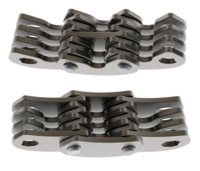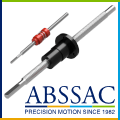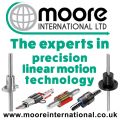
Posted to News on 26th Mar 2014, 00:00
Making the case for two-pin silent inverted chain drives
If you're considering gearboxes, timing belts or direct drives for your next compact drive system, but are concerned by factors such as high speed, noise, vibration, wear and load, then you just might find that two-pin silent inverted tooth chain is a better power transmission option. Mark Simms reports on a new product developed in the UK.

>In almost every field of design, there are ideas and concepts that seem to drift in and out of fashion. Sometimes there are good reasons why a particular concept is dropped, and yet how often do we see the idea revisited some years later when new manufacturing techniques make it cost-effective again or when some related idea solves a specific challenge.
>The problem in many fields of engineering, however, is that once a concept has drifted out of the fashion, the knowledge and skills required to make it can be quickly lost. A good example in the UK is inverted tooth chain, known more usually as 'silent chain'. We can trace the start of its decline to the 1950s, where it quickly lost ground to cheaper roller chain and even to belts. But there was a time when inverted tooth chain ruled supreme for power transmission.
>The first recorded use we can find for silent chain is when Isambard Kingdom Brunel used it as the main drive on the transatlantic passenger liner SS Great Britain. When launched in 1843, SS Great Britain was by far the largest vessel afloat, and certainly the most innovative, as the first iron hulled, screw propulsion vessel ever seen. Brunel admitted in his notes that he preferred the 'commonly in use' silent chain, showing it was probable that silent chain was in use for many years prior.
>How best to connect the two giant propeller engines to the propeller shafts was something of a puzzle, but Brunel was adamant that he didn't want to use gears, which he considered noisy and crude and certainly not suitable for a passenger ship. His solution was to install a gearing arrangement built around two massive sprockets - 18 feet and 6 feet in diameter - driven by silent inverted tooth chain weighing seven tonnes, to increase speed from 18rpm up to 53rpm.
>Working to his own design (we can speculate that perhaps he was influenced by a Leonardo da Vinci sketch that looked very much like an inverted tooth chain), Brunel even went to far as to build his own forge to make the links.
>Silent chain continued to enjoy much success - it was used as standard in vehicles such as Lagonda sports cars - and there was little to touch it for quiet, vibration-free operation until well into the 1950s. But inevitably gears improved, other chain technologies evolved, belt technology emerged, and silent chain began its fall from grace. With little development - in the UK at least - and the fact that teaching about inverted tooth chain on engineering courses quickly declined, applications for the technology spiralled downwards. So perhaps it is something of a surprise to find that one UK company - Pennine Industrial Equipment - has invested some 10,000 hours in design, upwards of £400,000 in machinery and some £500,000 in a new building in the development of a new silent inverted tooth power transmission chain. Pennine's PP and PPV are two-pin silent inverted tooth chains available in 3/8in and 1/2in pitch. So why this product, and why now?
>Sales director Graham Womersley explains: "We have been a leading supplier of silent chain products for many years, targeting some of the most demanding markets, and we recognised an opportunity in emerging applications for compact, high speed, low noise drives that it is difficult to satisfy with current power transmission technologies. The two-pin, silent inverted tooth chain offers higher load and speed than roller chain and other conventional chain products, while reducing vibration, noise and wear. Also, it can improve on geared solutions because it is much better at coping with shock loading or a non-fixed centre, and is more efficient."
>Womersley believes the new products are the first two-pin silent inverted tooth power transmission chains to be manufactured in the UK, and stresses that the company is making them from European high quality, high tolerance carbon steel. All components built into the chain go through processes to reduce material stress and fatigue. Compared with standard roller chain, the new design offers much higher maximum operating speeds, far quieter operation, smoother transmission of power, less impact and sliding as the chain engages the sprocket, higher efficiency (up to 99%), and longer sprocket life. The new design is also quieter than using spur gears, and the centre distance is much less restricted. Shaft location and parallelism tolerances are broader, and bearing loads are lower. There is no end thrust as you'd get with helical gears, and there is greater elasticity to absorb shock.
>Compared with belt drives, two-pin silent inverted tooth chain offers greater efficiency and larger ratios, and can withstand heavier loads. It can be used on a short centre distance at higher ratios, won't slip, is less affected by extremes of temperature or humidity, and offers lower bearing loads. It requires less space, and is detachable and so more easily installed. And it is effective in oil-filled gearboxes.
>Key to the impressive performance is the two-pin roller bearing joint. The links are manufactured using special techniques to keep the links flat and true. The link apertures also have to be accurate as they control pitch and reduce elongation. "This is what enables the high speed and the quiet running," explains Womersley. "The design eliminates chordal action so it runs more smoothly, which in turn means it is quiet and more efficient. The efficiency of 99% compares with a typical 90% efficiency for roller chain, while gear mechanisms are even worse. And the smooth running makes it ideal for applications such as grinders or for plastics manufacture.
>So whilst it can be tempting to turn straight to gears or direct drive motors for modern, compact drive systems, if there is any shock loading or a non-fixed centre, then two-pin silent inverted tooth chain could well be a better option."
Pennine Industrial Equipment Ltd
Unit A1
Park Mill Way
Clayton West
HD8 9XJ
UNITED KINGDOM
01484 864733
















